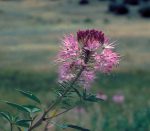 Rocky Mountain bee plant is an annual and a member of the Cleomaceae, a family closely related to mustards. It is native to western North America where it grows in prairies, open woods and disturbed sites from southern British Columbia, east to Minnesota, and south to Arizona and New Mexico. Plants grow 4-5′ tall and have a leafy branched stem bearing palmately compound leaves with 3 leaflets. From May to September the flowers appear in terminal racemes. Each nectar filled flower has 4 white to pink or purple petals and six 3″ long stamens that protrude beyond the petals. The cluster of flowers continue to elongate during the season so flowers and 4″ long drooping seed pods appear together and have a light airy spidery look. The flowers are very attractive to bees hence he common name but have a foul smell and are avoided by livestock. The genus name, Cleome, is of unknown origin. The specific epithet, serrulata, comes from the Latin word serratus, meaning saw-toothed and refers to the leaf margins.
Rocky Mountain bee plant is an annual and a member of the Cleomaceae, a family closely related to mustards. It is native to western North America where it grows in prairies, open woods and disturbed sites from southern British Columbia, east to Minnesota, and south to Arizona and New Mexico. Plants grow 4-5′ tall and have a leafy branched stem bearing palmately compound leaves with 3 leaflets. From May to September the flowers appear in terminal racemes. Each nectar filled flower has 4 white to pink or purple petals and six 3″ long stamens that protrude beyond the petals. The cluster of flowers continue to elongate during the season so flowers and 4″ long drooping seed pods appear together and have a light airy spidery look. The flowers are very attractive to bees hence he common name but have a foul smell and are avoided by livestock. The genus name, Cleome, is of unknown origin. The specific epithet, serrulata, comes from the Latin word serratus, meaning saw-toothed and refers to the leaf margins.
Type: Annual
Bloom: Racemes of white to pink or purple flowers from May to September
Size: 4-5′ H
Light: Full sun to part shade
Soil: Average, dry, well-drained
Hardiness: Not applicable
Care: Low maintenance
Pests and Diseases: None of significance
Propagation: Seed
Companion Plants: Prairie sage, autumn fire stone crop, silky thread grass
Photo Credit: Wikipedia